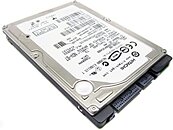- Joined
- Oct 9, 2007
- Messages
- 47,417 (7.51/day)
- Location
- Hyderabad, India
| System Name | RBMK-1000 |
|---|---|
| Processor | AMD Ryzen 7 5700G |
| Motherboard | ASUS ROG Strix B450-E Gaming |
| Cooling | DeepCool Gammax L240 V2 |
| Memory | 2x 8GB G.Skill Sniper X |
| Video Card(s) | Palit GeForce RTX 2080 SUPER GameRock |
| Storage | Western Digital Black NVMe 512GB |
| Display(s) | BenQ 1440p 60 Hz 27-inch |
| Case | Corsair Carbide 100R |
| Audio Device(s) | ASUS SupremeFX S1220A |
| Power Supply | Cooler Master MWE Gold 650W |
| Mouse | ASUS ROG Strix Impact |
| Keyboard | Gamdias Hermes E2 |
| Software | Windows 11 Pro |
PC OEMs have revealed to market intelligence firm Trendfocus that Microsoft wants them to stop the use of hard-disk drives (HDDs, or mechanical hard-drives) as the main boot device in products powered by Windows 11, from 2023. It's not known how the company will go about enforcing this. One theory holds that it may amend the Minimum System Requirements for the operating system to specify a flash-based storage device, such as an SSD. If push comes to shove, the OS could even refuse to deploy on a machine with an HDD as the boot device.
What's also not known is how this affects SSHDs (hard drives with tiny flash-based storage media and an access-based data-juggling mechanism). Microsoft's decision should come as a boon for entry-level notebook and desktop buyers; as this segment sees OEMs use HDDs as the boot device, the most. There could be a push toward at least DRAMless QLC SSDs, or even single-chip SSDs. Regardless, it's clear that 2.5-inch HDDs are on their way out of the industry. HDD as a technology may still exist in the 3.5-inch form-factor, as they are in high demand from the data-center and surveillance markets as cold storage devices.

View at TechPowerUp Main Site | Source
What's also not known is how this affects SSHDs (hard drives with tiny flash-based storage media and an access-based data-juggling mechanism). Microsoft's decision should come as a boon for entry-level notebook and desktop buyers; as this segment sees OEMs use HDDs as the boot device, the most. There could be a push toward at least DRAMless QLC SSDs, or even single-chip SSDs. Regardless, it's clear that 2.5-inch HDDs are on their way out of the industry. HDD as a technology may still exist in the 3.5-inch form-factor, as they are in high demand from the data-center and surveillance markets as cold storage devices.

View at TechPowerUp Main Site | Source






